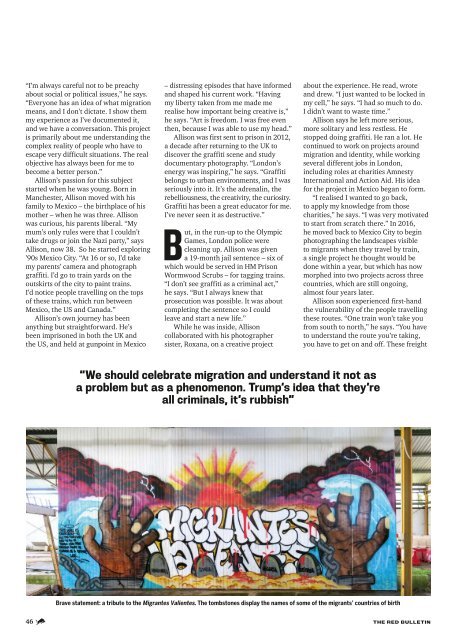You also want an ePaper? Increase the reach of your titles
YUMPU automatically turns print PDFs into web optimized ePapers that Google loves.
“I’m always careful not to be preachy<br />
about social or political issues,” he says.<br />
“Everyone has an idea of what migration<br />
means, and I don’t dictate. I show them<br />
my experience as I’ve documented it,<br />
and we have a conversation. This project<br />
is primarily about me understanding the<br />
complex reality of people who have to<br />
escape very difficult situations. <strong>The</strong> real<br />
objective has always been for me to<br />
become a better person.”<br />
Allison’s passion for this subject<br />
started when he was young. Born in<br />
Manchester, Allison moved with his<br />
family to Mexico – the birthplace of his<br />
mother – when he was three. Allison<br />
was curious, his parents liberal. “My<br />
mum’s only rules were that I couldn’t<br />
take drugs or join the Nazi party,” says<br />
Allison, now 38. So he started exploring<br />
’90s Mexico City. “At 16 or so, I’d take<br />
my parents’ camera and photograph<br />
graffiti. I’d go to train yards on the<br />
outskirts of the city to paint trains.<br />
I’d notice people travelling on the tops<br />
of these trains, which run between<br />
Mexico, the US and Canada.”<br />
Allison’s own journey has been<br />
anything but straightforward. He’s<br />
been imprisoned in both the <strong>UK</strong> and<br />
the US, and held at gunpoint in Mexico<br />
– distressing episodes that have informed<br />
and shaped his current work. “Having<br />
my liberty taken from me made me<br />
realise how important being creative is,”<br />
he says. “Art is freedom. I was free even<br />
then, because I was able to use my head.”<br />
Allison was first sent to prison in 2012,<br />
a decade after returning to the <strong>UK</strong> to<br />
discover the graffiti scene and study<br />
documentary photography. “London’s<br />
energy was inspiring,” he says. “Graffiti<br />
belongs to urban environments, and I was<br />
seriously into it. It’s the adrenalin, the<br />
rebelliousness, the creativity, the curiosity.<br />
Graffiti has been a great educator for me.<br />
I’ve never seen it as destructive.”<br />
But, in the run-up to the Olympic<br />
Games, London police were<br />
cleaning up. Allison was given<br />
a 19-month jail sentence – six of<br />
which would be served in HM Prison<br />
Wormwood Scrubs – for tagging trains.<br />
“I don’t see graffiti as a criminal act,”<br />
he says. “But I always knew that<br />
prosecution was possible. It was about<br />
completing the sentence so I could<br />
leave and start a new life.”<br />
While he was inside, Allison<br />
collaborated with his photographer<br />
sister, Roxana, on a creative project<br />
about the experience. He read, wrote<br />
and drew. “I just wanted to be locked in<br />
my cell,” he says. “I had so much to do.<br />
I didn’t want to waste time.”<br />
Allison says he left more serious,<br />
more solitary and less restless. He<br />
stopped doing graffiti. He ran a lot. He<br />
continued to work on projects around<br />
migration and identity, while working<br />
several different jobs in London,<br />
including roles at charities Amnesty<br />
International and Action Aid. His idea<br />
for the project in Mexico began to form.<br />
“I realised I wanted to go back,<br />
to apply my knowledge from those<br />
charities,” he says. “I was very motivated<br />
to start from scratch there.” In 2016,<br />
he moved back to Mexico City to begin<br />
photographing the landscapes visible<br />
to migrants when they travel by train,<br />
a single project he thought would be<br />
done within a year, but which has now<br />
morphed into two projects across three<br />
countries, which are still ongoing,<br />
almost four years later.<br />
Allison soon experienced first-hand<br />
the vulnerability of the people travelling<br />
these routes. “One train won’t take you<br />
from south to north,” he says. “You have<br />
to understand the route you’re taking,<br />
you have to get on and off. <strong>The</strong>se freight<br />
“We should celebrate migration and understand it not as<br />
a problem but as a phenomenon. Trump’s idea that they’re<br />
all criminals, it’s rubbish”<br />
Brave statement: a tribute to the Migrantes Valientes. <strong>The</strong> tombstones display the names of some of the migrants’ countries of birth<br />
46 THE RED BULLETIN

















